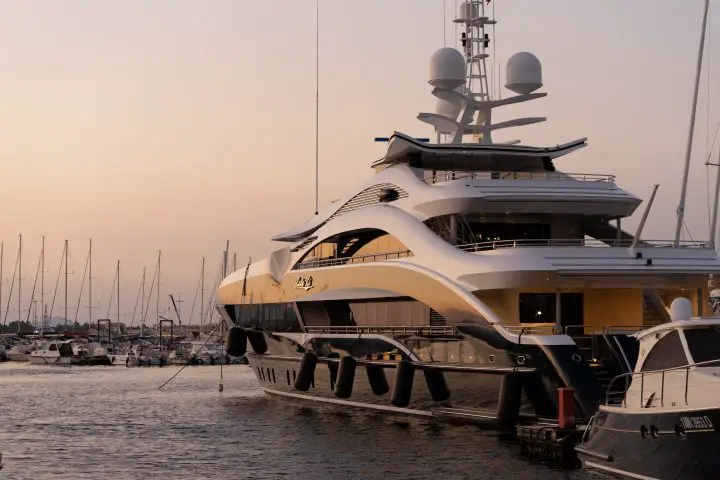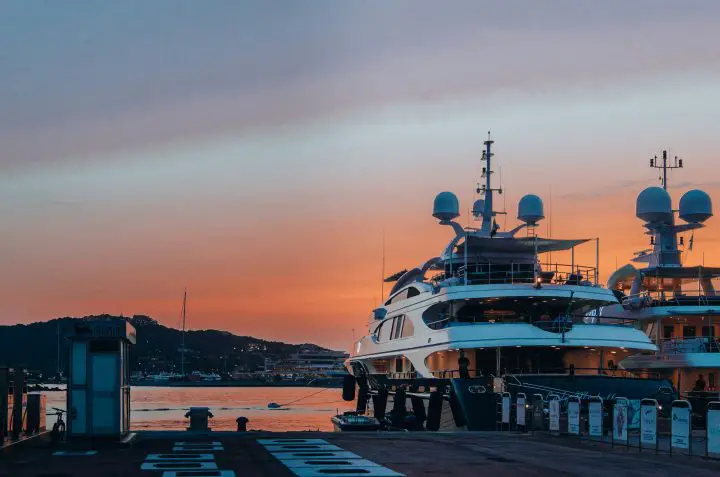Exploring the types of boats you can live on opens a world of possibilities for those seeking freedom from traditional housing constraints. Navigating the complex world of liveaboard vessels can feel overwhelming, with countless options making it difficult to determine which floating home might best suit your needs, budget, and sailing abilities. Whether you’re fleeing skyrocketing rent prices, pursuing a minimalist lifestyle, or simply answering the call of adventure, this guide cuts through the confusion. Discover the seven types of boats you can live on that could transform your relationship with “home,” complete with real-world insights from those already living their waterborne dreams.

Table of Contents
- Houseboats
- Sailboats
- Catamarans
- Trawlers
- Yachts & Motor Cruisers
- Narrowboats & Canal Boats
- Find Your Dream Floating Home
- FAQs
Houseboats
Unlike cruisers built for travel, these vessels prioritize comfortable living with amenities rivaling conventional houses. Companies like Harbor Cottage Houseboats create designs featuring full kitchens, multiple bedrooms, and spacious living areas—all with spectacular waterfront views.
Before committing to this lifestyle, you’ll need to research marina docking regulations, which vary significantly by location. Permanent mooring options exist, but they come with monthly slip fees and specific rules about residency.
Barge homes represent a spacious alternative with their wide, flat-bottomed design, offering more square footage and stability than traditional houseboats—perfect for families or those reluctant to downsize dramatically.
Pros:
- Wake up to ever-changing waterfront views
- Strong community atmosphere in marina settings
- Potentially lower cost than waterfront property
- Opportunity for sustainable living with solar panels
- Ability to relocate (though limited) without changing homes
Cons:
- Unique maintenance challenges from constant water exposure
- Variable marina fees that can be surprisingly expensive
- Limited mobility compared to true cruising vessels
- Reduced privacy in marina communities
- Subject to weather conditions and water level changes
Sailboats
Imagine waking up in a new anchorage every few days, your home gently rocking as you sip morning coffee. This isn’t vacation—it’s everyday life for liveaboard sailors! Sailboats offer the ultimate mobile lifestyle, powered by wind and designed for crossing oceans.
You’ve got choices here: classic monohulls like Island Packet and Hallberg-Rassy provide that authentic sailing feel with their sleek design, while catamarans from Lagoon and Fountaine Pajot offer more living space and stability (at a higher price tag). True bluewater vessels come equipped with stronger rigging and redundant systems for those dreaming of offshore adventures.
Unlike houseboats, sailboats give you nearly unlimited mobility—just follow the trade winds to your next destination. The cruising community you’ll meet along the way often becomes like extended family, sharing anchorages, potluck dinners, and tips about hidden coves.
Pros:
- Freedom to explore coastlines and cross oceans
- Wind power means minimal fuel costs
- A strong community of fellow cruisers worldwide
- Skills-building lifestyle (navigation, weather reading, maintenance)
- Ability to access remote locations inaccessible by land
Cons:
- The learning curve for sailing skills
- Limited fresh water and power
- Weather dependency
- Maintenance in the salt environment is constant
- Smaller living space compared to houseboats
Related: 17 Best Sailboats to Live On
Catamarans
These twin-hulled boats offer a completely different liveaboard lifestyle than traditional monohulls. Cats (as enthusiasts call them) deliver rock-solid stability that practically eliminates the constant rolling you’d experience on other sailboats. Top builders like Lagoon, Leopard, and Fountaine Pajot create designs with sprawling salon areas spanning the entire beam between hulls – think living rooms that rival small apartments.
If you’ve got family or plan to host guests, catamarans shine with their clever separation of living spaces. Parents can enjoy their hull while kids occupy the opposite side. The wide, flat decks provide safe lounging areas with those trampolines up front becoming everyone’s favorite spot to watch dolphins play.
For offshore living, modern cats offer storage solutions that monohulls can’t match, though they’ll cost you 30-50% more than comparable length boats.
Pros:
- Exceptional stability means less seasickness
- Significantly more living space than monohulls
- Shallow draft for accessing secluded anchorages
- Natural separation of living spaces for privacy
- Level sailing without constant heeling
Cons:
- Higher purchase price than comparable monohulls
- Require larger (and pricier) marina slips
- Less efficient sailing upwind
- More systems to maintain with two engines
- Limited options for hauling out for maintenance
Related: Top 18 Boats with Living Quarters
Trawlers
These sturdy powerboats, inspired by commercial fishing vessels, offer luxurious living spaces perfect for long-distance cruising.
Brands like Grand Banks deliver classic teak-accented interiors that feel more like upscale apartments than boats. You won’t win any races in a Nordhavn—cruising between 7-10 knots—but you might travel over 3,000 nautical miles without refueling! That slow-speed cruising translates directly to your wallet too, with impressive fuel efficiency compared to faster vessels.
Kadey-Krogen designs maximize interior volume with wide-body hulls, creating genuinely livable spaces with full-sized galleys, separate shower stalls, and legitimate owner’s staterooms. Many even feature raised pilothouses offering panoramic views while underway.
Pros:
- Self-sufficient design for weeks away from marinas
- Exceptional stability in rough conditions
- Spacious layouts without typical “boat living” compromises
- Long-range travel capabilities
- Easier learning curve than sailboats
Cons:
- Higher purchase price than comparable sailboats
- Requires mechanical knowledge
- A slower pace means planning around the weather
- Not all marinas accommodate wider beam designs
- Ongoing diesel maintenance costs

Yachts & Motor Cruisers
Living on a luxury yacht is like having your waterfront penthouse that just happens to move. These floating palaces from builders like Sunseeker, Azimut, and Princess Yachts offer unmatched comfort with high-end finishes you’d expect in luxury homes—think Italian marble countertops, designer furniture, and smart home technology.
The lifestyle difference is dramatic compared to other liveaboard options. You’ll find climate-controlled interiors, entertainment systems that rival home theaters, and master suites with panoramic water views. Many Azimut models feature separate crew quarters, allowing you to hire help for maintenance and navigation if your budget allows.
Princess Yachts excel at creating entertainment spaces with flybridge designs perfect for hosting gatherings while moored at exclusive marinas. The social scene becomes part of the package—you’re instantly welcomed into a community of like-minded owners.
Pros:
- Luxurious accommodations without compromise
- Impressive speed for weekend getaways
- Status and prestige in marina communities
- Excellent resale value for premium brands
- Modern amenities rival luxury homes
Cons:
- Eye-watering purchase prices and operating costs
- Substantial depreciation in early years
- High fuel consumption limits cruising range
- Requires professional maintenance
- Expensive insurance and marina fees
Narrowboats & Canal Boats
Narrowboats (typically just 7 feet wide) are designed specifically for the historic canal networks of the UK, though similar canal boat lifestyles exist in parts of Europe and North America.
Unlike houseboats, narrowboats are built for genuine mobility, with many “continuous cruisers” embracing a nomadic lifestyle that requires moving every 14 days under UK regulations. The liveaboard narrowboat communities have developed their own vibrant culture, with impromptu towpath gatherings and a strong ethos of mutual support.
These vessels maximize space ingeniously—think clever storage solutions, multi-purpose furniture, and cozy wood-burning stoves that transform the interior into a floating cottage. The affordability factor is impressive too, with decent liveaboard models available for the price of a down payment on many conventional homes.
Pros:
- Lower cost entry point than most liveaboard options
- Access to charming inland locations inaccessible to other boats
- Strong, supportive community of fellow boaters
- Relatively simple systems that most owners can maintain
- Significantly lower carbon footprint than other lifestyles
Cons:
- Limited space requires serious downsizing
- Weather-dependent comfort (especially in winter)
- Restrictive cruising regulations in some areas
- Regular lock operation can be physically demanding
- Limited water and power require a conservation mindset
Find Your Dream Floating Home
Finding the right liveaboard boat depends entirely on your lifestyle needs. Solo adventurers thrive on 32-36 foot monohulls like the Island Packet 35, offering manageability without sacrificing comfort. Couples enjoy roomier 38-44 foot vessels or modest catamarans like the popular Leopard 38. Families need space—larger catamarans such as the Lagoon 42 provide separate quarters and common areas. Budget-conscious sailors should consider older fiberglass monohulls or classic trawlers. Remember: the best boat matches your dreams, skills, and budget.
FAQs
Can you live permanently on a boat?
Yes, you can live permanently on a boat. This lifestyle, known as “liveaboard,” is legal in many places with proper documentation and marina approval. You’ll need to consider practicalities like mail service, residency requirements, insurance, and access to amenities. Many full-time liveaboards successfully make their boats their primary residence year-round.
What do you call a boat you can live on?
A boat you can live on is called a “liveaboard.” This term applies to any vessel equipped for full-time habitation, regardless of type or size. Popular liveaboard options include houseboats, trawlers, sailboats, and canal boats. The vessel becomes classified as a liveaboard when someone uses it as their primary residence rather than just for recreation.
What type of boat is easiest to maintain?
Fiberglass powerboats with outboard motors are generally the easiest boats to maintain. They require less upkeep than wooden vessels, which need constant protection against rot and marine organisms. Outboard motors are accessible and simpler to service compared to inboard engines. Smaller boats with minimal systems (plumbing, electrical) also reduce maintenance needs and associated costs.
What size yacht can you live on?
You can comfortably live on yachts ranging from 30 to 45 feet. While some adventurous sailors manage on boats as small as 24 feet, most find 36-40 feet ideal for full-time living, offering sufficient space without excessive maintenance or mooring costs. Larger yachts (45+ feet) provide more comfort but require bigger budgets and advanced handling skills.
